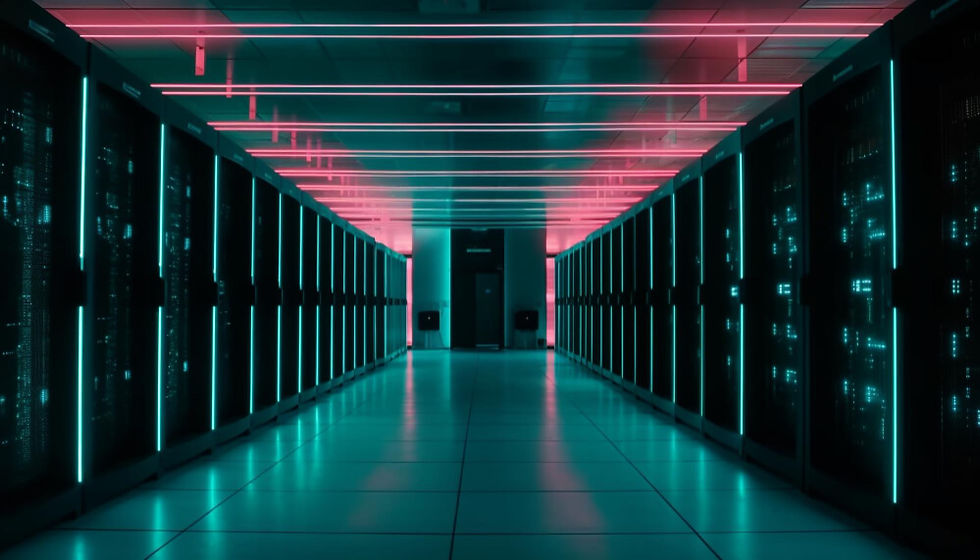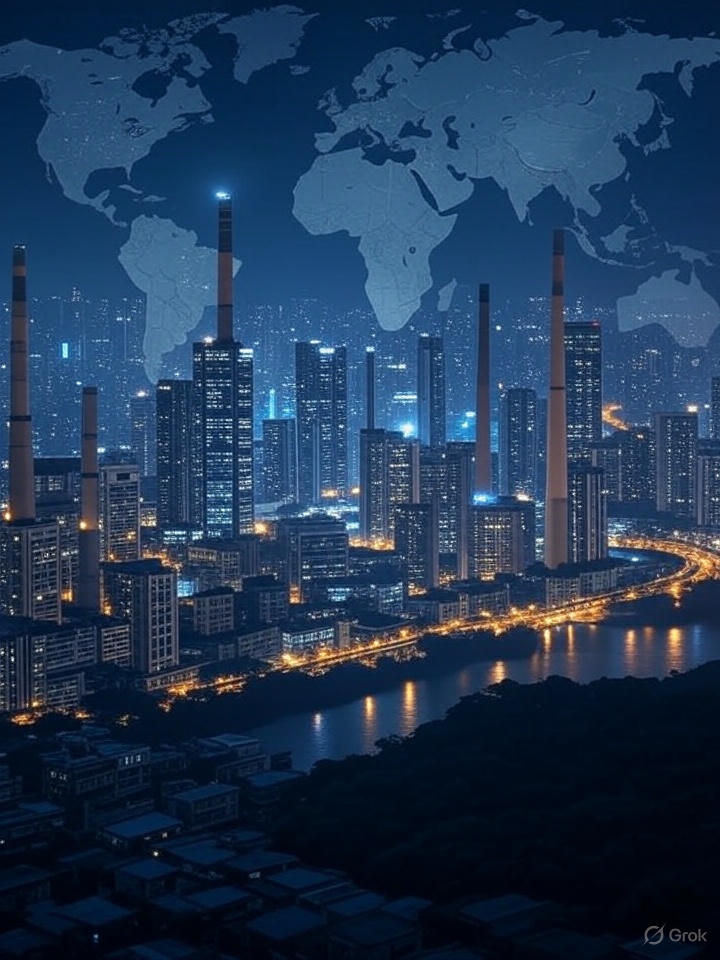The AI Data Center Gold Rush: A Ticking Economic Bomb
- thebrink2028
- Sep 6
- 5 min read

A City of Servers
In the Nevada desert, where the sun scorches the earth to a brittle crust, a gleaming fortress of steel and glass hums with the promise of tomorrow. This is "NovaCore," a hyperscale AI data center that locals call "The Beast." It sprawls across 200 acres, its cooling towers exhaling plumes of heat into the sky, a monument to human ambition. Inside, thousands of GPUs churn through petabytes of data, training AI models that power everything from virtual assistants to autonomous drones. At night, the facility glows like a spaceship, but its balance sheets are shrouded in darkness. Last month, NovaCore’s operator is burning $2 million a day to keep the lights on, and the revenue from cloud leases barely covers a fifth of that. Workers on the ground—electricians, cooling techs, security guards—talk of layoffs. The question hangs heavy in the dry air: If the future is AI, why is this marvel of engineering already drowning in red ink?
Depreciation Is Eating AI Data Centers Alive
The economics of hyperscale AI data centers are a house of cards. TheBrink analysis estimates that new AI data centers face $40 billion in annual depreciation while generating only $15–20 billion in revenue. GPUs, the heart of AI compute, become obsolete every 2–4 years, forcing operators to replace them at a cost of $10,000–$30,000 per unit. Networking systems last about a decade, and even buildings, while durable, require costly retrofits to handle escalating power and cooling demands. For example, a Midwest operator ("MidTech") reported that 60% of its capital expenditure went to replacing outdated hardware, not expanding capacity. Meanwhile, global benchmarks show European data centers, with stricter energy regulations, face even higher retrofit costs, averaging $50 million per facility annually. The narrative of "build and profit" ignores this relentless churn.
Power Costs Are Crippling Operators
AI data centers are electricity hogs. A single high-density rack can consume 50 kW, compared to 20 kW for traditional setups in 2020. TheBrink projects a 160% increase in global data center power demand by 2030, with AI workloads driving 27% of that. In Virginia, a hub for U.S. data centers, utility providers reported that hyperscale facilities requested 1,000 MW connections—equivalent to powering a small city—straining grids to breaking points. Local communities face rolling blackouts as utilities prioritize corporate clients. In Ireland, a 2024 moratorium on new data center permits highlighted the unsustainability of unchecked power consumption, but U.S. operators continue to secure exemptions, passing costs to taxpayers. Operators are locked into long-term power contracts at rates that no longer match market realities, squeezing margins further.
Revenue Growth Falls Behind Capex
The capital expenditure (capex) for AI data centers is around $375 billion projected for 2025, climbing to $500 billion by 2026. But, revenue isn’t keeping pace. TheBrink estimates U.S. data centers would need $480 billion in annual revenue to achieve a normal return, compared to the current $20 billion. Hyperscalers like "CloudTitan" and "DataWave" lease capacity to AI startups, but demand is volatile. A Silicon Valley AI firm, "NeuraNest," signed a $100 million lease in 2024, only to scale back 40% in 2025 when its model training hit diminishing returns. Globally, Asia-Pacific centers face similar issues, with 27% of capacity underutilized due to overbuilding. The promise of exponential AI demand is faltering against the reality of finite budgets.
The Timeline of Drivers
2018–2020: The AI Hype Begins. Early generative AI models spark investor frenzy. Tech giants pour $50 billion annually into data center expansion, driven by policy incentives like U.S. tax breaks for "green tech." Geopolitical tensions push companies to localize data centers, inflating costs.
2021–2023: Chip Shortages and Power Crunches. Semiconductor supply chains falter, driving GPU prices up 30%. Power grids in key markets like Texas and Virginia face overloads, with utilities reporting 2–4-year delays for new connections. Operators overbuild, betting on future AI demand.
2024: The Spending Spree Peaks. Hyperscalers spend $211 billion on capex, with 70% tied to AI infrastructure. Open-source AI models like those from "DeepCore" flood the market, reducing pricing power for proprietary providers. Environmental regulations fall behind, allowing unchecked expansion.
2025: The Reality Check. Depreciation outpaces revenue as hardware obsolescence accelerates. Local communities protest power grid strain demanding transparency. Operators face a choice: scale back or double down on risky bets.
What the News Hides
The mainstream narrative paints AI data centers as economic saviors, creating jobs and innovation. But TheBrink tells a different story. Job creation is overstated—most roles are low-wage, temporary contractor positions, with 80% of data center jobs in rural U.S. areas paying below $20/hour. Environmental costs are buried. Data centers consumed 524 TWh globally in 2023, projected to hit 1,743 TWh by 2030, but corporate sustainability pledges obscure the reliance on fossil fuel backups during grid failures. The financial risk is downplayed. Analysts warn that operators need a 10x revenue increase to break even, a figure absent from optimistic earnings calls. These omissions skew public perception, framing data centers as inevitable progress while ignoring their toll on communities and investors. The lack of transparency limits informed decision-making, leaving policymakers and citizens unprepared for the fallout.
The Brink: What Happens Next
The Bubble Bursts
Triggered by Power grid failures in key markets like Texas or California, coupled with a slowdown in AI adoption as enterprises prioritize cost over innovation. Regulatory crackdowns in the EU and U.S. impose stricter energy caps. Expected around Mid-2026, operators will report quarterly losses exceeding $10 billion. Hyperscalers will scale back expansion, leading to $100 billion in stranded assets. Small operators will file for bankruptcy, and chipmakers like "SiliconPeak" see a 20% stock drop. Communities near failed centers will face economic stagnation. Historical tech bubbles (e.g., dot-com crash) show over investment leads to rapid contraction when returns falter. Current capex-revenue gaps and grid constraints make this plausible.
But There is A Pivot to Efficiency
With breakthroughs in chip efficiency can reduce power consumption by 30%, and modular data center designs cut depreciation costs. Governments will offer subsidies for sustainable retrofits.
Plausible by late 2027, as pilot projects will prove to be viable. Operators will stabilize margins, with revenue reaching $200 billion by 2030. Rural communities will gain stable jobs from retrofitting projects. Global standards will emerge for energy-efficient AI infrastructure.
Innovations in cooling (e.g., liquid cooling adoption, up 40% in 2025) and chip design will bridge the gap, but scaling these solutions requires time and coordination, making it a lowering likelihood in current situation.
Sponsor Thank-You: A Heartfelt Nod to "GreenSpark Solutions"
To the small-town engineers at GreenSpark Solutions, a startup fighting to retrofit data centers with sustainable cooling systems: your late-night experiments in a garage-turned-lab are a beacon of hope. Founded by a former data center technician who saw his community’s power grid buckle under hyperscale demand, GreenSpark’s mission to cut energy waste by 25% is the kind of human ingenuity that keeps us grounded.
If you’d like to back a topic that needs daylight or share this article with our 10,000+ readers, visit our sponsor page or spread the word to grow this community.
-Chetan Desai
Your awareness is the first step—by simply engaging with truths many fear to face, you're already part of TheBrink movement.
We'd love to invite you to subscribe to ensure you never miss our content. Many platforms and social media channels have been restricting or removing our posts, so subscribing is the best way to receive our stories directly in your inbox, unfiltered and uncensored.
Your sponsorships and donations fuel our mission to uncover hidden truths and inspire change. Click "Sponsor" or contact thebrink2028@gmail.com for partnership opportunities.
Thank you for being part of this journey.


